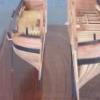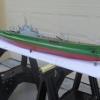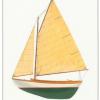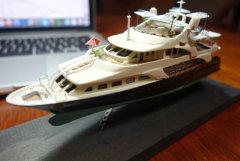MORE HANDBOOKS ARE ON THEIR WAY! We will let you know when they get here.
×
-
Posts
885 -
Joined
-
Last visited
Reputation Activity
-
 Julie Mo got a reaction from Canute in Reading Boat Drawings
Julie Mo got a reaction from Canute in Reading Boat Drawings
Thanks for the answers, guys, but please don't dismiss the class yet.
I understood everything you said, Wayne. I figured the lines on the top view and side view drawings were planes slicing through the hull. What I didn't figure was the station lines may not necessarily reflect frame shape and location. I thought they were there specifically to design the frames. But I would imagine if you made frames based on station lines, you should replicate the intended hull design. Correct?
For model building purposes, could you use the station lines to create the frames? And, theoretically, should that method give you a reasonable facsimile of the actual ship/boat hull?
-
 Julie Mo got a reaction from Canute in Reading Boat Drawings
Julie Mo got a reaction from Canute in Reading Boat Drawings
Thank you, Ron.
Next question, when looking at the bottom picture in the first post, the lines from bow to stern should be created by the planking. Right?
Same with this drawing... I can see it adds the water line and the keel and rudder shape. But as far as the hull shape, that should be created by the frames being placed in the correct location and planking the hull?
-
 Julie Mo got a reaction from dgbot in Reading Boat Drawings
Julie Mo got a reaction from dgbot in Reading Boat Drawings
I think I'm beginning to understand boat drawings. I have seen line drawings many times but never stopped to figure out what is going on. It wasn't until I began my first model that I actually started to put it all together. But I'm not sure I have this right.
What I think I am seeing with the hull lines is the frames from the bow to midships on the right and from midships to stern on the left. So if you cut the drawing above down the middle, and took each half and made mirror images of the other half, you would have all the frames necessary to duplicate the shape of the hull.
Next you take those frames and place them where the vertical lines are on the above drawing, from "0" to "20". Then you plank it and you have the hull.
Am I on the right track?
-
 Julie Mo got a reaction from Piet in VOLVO 65 by pete48 - FINISHED - Scale 1/4" = 1' - Farr Yacht Design
Julie Mo got a reaction from Piet in VOLVO 65 by pete48 - FINISHED - Scale 1/4" = 1' - Farr Yacht Design
Thanks, Pete. I've been envisioning using a plane to get the rough shape then use different length pieces of MDF with PSA sandpaper attached to finish it off. For my guitar necks I start with a spokeshave but I think a plane would be better on a mast. We'll see...
-
 Julie Mo reacted to mtaylor in Reading Boat Drawings
Julie Mo reacted to mtaylor in Reading Boat Drawings
Julie,
As I recall, that link to the database, there's a multipart tutorial on using AutoCAD for this. I'm not sure what "level" it is for, however. By level.. newbie, mid-level that has some knowledge of AutoCAD and ship's lines, or expert.
-
 Julie Mo reacted to lehmann in Reading Boat Drawings
Julie Mo reacted to lehmann in Reading Boat Drawings
I'm assuming here that your underlying question is how to use the lines drawing to build your model....
Each set of curves, sections, waterlines, buttock lines, (and even diagonals) could be used individually to describe a hull. Layers of wood, of the appropriate thickness and profile, can be glued together and smoothed to form a hull. This is basically, old-school 3D printing, where the thinner the sections, the less smoothing is needed. You can do this in any of the three directions (if you're really good, you could even glue up wedges shaped from the diagonals!). One professional modeler, Phillip Reed, makes his frames by stacking layers longitudinally with each layer having the thickness of the frame. He then smooths the solid hull. When done, he removes every second layer to get a set of evenly spaced frames ready to be attached to the keel.
The other method is to build sections, which are basically the same as the frames used in construction of a full sized wooden hull if the thickness of the planking is accounted for. As mentioned in a previous post, the location and spacing of the sections in a lines drawing are arbitrary and chosen for the convenience of the the designer, mainly to make the calculations for displacement and stability easier. In construction, there are many more frames than there are sections. Even for a plank-on-bulkhead model, it's a good idea to have more bulkheads than there are sections in the plans so that the planking is better supported. To get the frame or bulkhead shapes, just add new section lines to the drawing where ever the frames are to go. In some ships some of the frames are not square to the centerline (in the plan view), but are canted: you can work out the shape of these canted frames by just adding canted section lines and working out their shape. There are also drafting methods to get the shape of the transom.
So, yes, you can get a 3D shape of the hull from the drawings, but you may not want to use it directly to build your model (or real ship). However, you can extract all the shapes from the lines drawing.
A few points to consider:
Since the frames have thickness and the surfaces will have to be beveled so the planks fit properly, the profile of the sawn frame has to be from the widest side of the frame (usually, the side closest to mid-ship) As mentioned above, take into account the thickness of the planking when drawing the frames. In plank-on-bulkhead construction it is common to use two layers of planking (double-plank) to better ensure that the final planking layer is properly supported and fair (smooth). For a full ship ship, these details are worked out by on a full size drawing - and the process is termed "lofting".
Bruce
-
 Julie Mo got a reaction from Eddie in Endeavour 1934 by Julie Mo - Amati - Scale 1:35 - America's Cup UK J-Class Challenger
Julie Mo got a reaction from Eddie in Endeavour 1934 by Julie Mo - Amati - Scale 1:35 - America's Cup UK J-Class Challenger
Packing for a late Wednesday move.
To be continued...
-
 Julie Mo got a reaction from hexnut in Endeavour 1934 by Julie Mo - Amati - Scale 1:35 - America's Cup UK J-Class Challenger
Julie Mo got a reaction from hexnut in Endeavour 1934 by Julie Mo - Amati - Scale 1:35 - America's Cup UK J-Class Challenger
Packing for a late Wednesday move.
To be continued...
-
 Julie Mo got a reaction from captainbob in VOLVO 65 by pete48 - FINISHED - Scale 1/4" = 1' - Farr Yacht Design
Julie Mo got a reaction from captainbob in VOLVO 65 by pete48 - FINISHED - Scale 1/4" = 1' - Farr Yacht Design
Thanks, Pete. I've been envisioning using a plane to get the rough shape then use different length pieces of MDF with PSA sandpaper attached to finish it off. For my guitar necks I start with a spokeshave but I think a plane would be better on a mast. We'll see...
-
 Julie Mo reacted to michael mott in VOLVO 65 by pete48 - FINISHED - Scale 1/4" = 1' - Farr Yacht Design
Julie Mo reacted to michael mott in VOLVO 65 by pete48 - FINISHED - Scale 1/4" = 1' - Farr Yacht Design
Nice work on the mast Pete. I am always surprised by your skills with the x-acto knives, I would have used a block plane.
A trick I learned recently is to have a sub sheet covered with some 120 grit paper then place my wood to be planed on it so that I can plane fine strips and tapers. the grit holds the piece without any fuss and doesn't seem to create any issues with the side facing the sandpaper. Also the set on the plane needs to be very fine.
Michael
-
 Julie Mo got a reaction from michael mott in VOLVO 65 by pete48 - FINISHED - Scale 1/4" = 1' - Farr Yacht Design
Julie Mo got a reaction from michael mott in VOLVO 65 by pete48 - FINISHED - Scale 1/4" = 1' - Farr Yacht Design
Thanks, Pete. I've been envisioning using a plane to get the rough shape then use different length pieces of MDF with PSA sandpaper attached to finish it off. For my guitar necks I start with a spokeshave but I think a plane would be better on a mast. We'll see...
-
 Julie Mo got a reaction from mtaylor in VOLVO 65 by pete48 - FINISHED - Scale 1/4" = 1' - Farr Yacht Design
Julie Mo got a reaction from mtaylor in VOLVO 65 by pete48 - FINISHED - Scale 1/4" = 1' - Farr Yacht Design
Thanks, Pete. I've been envisioning using a plane to get the rough shape then use different length pieces of MDF with PSA sandpaper attached to finish it off. For my guitar necks I start with a spokeshave but I think a plane would be better on a mast. We'll see...
-
 Julie Mo got a reaction from pete48 in VOLVO 65 by pete48 - FINISHED - Scale 1/4" = 1' - Farr Yacht Design
Julie Mo got a reaction from pete48 in VOLVO 65 by pete48 - FINISHED - Scale 1/4" = 1' - Farr Yacht Design
Thanks, Pete. I've been envisioning using a plane to get the rough shape then use different length pieces of MDF with PSA sandpaper attached to finish it off. For my guitar necks I start with a spokeshave but I think a plane would be better on a mast. We'll see...
-
 Julie Mo got a reaction from Omega1234 in VOLVO 65 by pete48 - FINISHED - Scale 1/4" = 1' - Farr Yacht Design
Julie Mo got a reaction from Omega1234 in VOLVO 65 by pete48 - FINISHED - Scale 1/4" = 1' - Farr Yacht Design
Thanks, Pete. I've been envisioning using a plane to get the rough shape then use different length pieces of MDF with PSA sandpaper attached to finish it off. For my guitar necks I start with a spokeshave but I think a plane would be better on a mast. We'll see...
-
 Julie Mo reacted to pete48 in VOLVO 65 by pete48 - FINISHED - Scale 1/4" = 1' - Farr Yacht Design
Julie Mo reacted to pete48 in VOLVO 65 by pete48 - FINISHED - Scale 1/4" = 1' - Farr Yacht Design
Hi Julie Mo, To cut out the Mast, I used a large X-ACTO knife with a #22 Blade ( it is pictured in the mast only shot with the Red handle ) I then used a few different wood files, followed by Sandpaper starting with 180 grit working my way up to 320 grit. The key is to take your time
Best Regards,
Pete
-
 Julie Mo got a reaction from Omega1234 in VOLVO 65 by pete48 - FINISHED - Scale 1/4" = 1' - Farr Yacht Design
Julie Mo got a reaction from Omega1234 in VOLVO 65 by pete48 - FINISHED - Scale 1/4" = 1' - Farr Yacht Design
Pete, what did you use to taper the mast?
-
 Julie Mo got a reaction from pete48 in VOLVO 65 by pete48 - FINISHED - Scale 1/4" = 1' - Farr Yacht Design
Julie Mo got a reaction from pete48 in VOLVO 65 by pete48 - FINISHED - Scale 1/4" = 1' - Farr Yacht Design
Pete, what did you use to taper the mast?
-
 Julie Mo got a reaction from Canute in Reading Boat Drawings
Julie Mo got a reaction from Canute in Reading Boat Drawings
Mark, thanks for the link. I had been on that page but missed that particular article. I read through it and I think I pretty much understand what's going on.
Next step for me will be to apply my understanding of all this into a CAD drawing. I have AutoCAD MEP, which is intended for mechanical, electrical and plumbing in buildings but I can make it work for modeling purposes. It will be interesting to see how this works out. German Frers, look out!
-
 Julie Mo reacted to trippwj in Reading Boat Drawings
Julie Mo reacted to trippwj in Reading Boat Drawings
Julie - you are off to a good start, but a couple of corrections.
The first body plan - the lines are station lines which, in most cases align with a frame but not all frames are shown. The curved horizontal lines in your next query are somewhat arbitrary lines. They are waterlines decided by the draftsman representing fixed intervals up from the baseline (they are straight horizontal lines in the sheer plan). They show the shape of the hull at that level.
The curved lines in the final plan do not show planking, but rather hull shape at a fixed distance out from the centerline (imagine slices from bow to stern). Again, the size of each slice was somewhat arbitrary, though fixed on a given plan.
Confused yet?
-
 Julie Mo reacted to mtaylor in Reading Boat Drawings
Julie Mo reacted to mtaylor in Reading Boat Drawings
Julie,
Have a look here.. http://modelshipworldforum.com/ship-model-plans-and-research.php
The second article by Russell Barnes. He pretty much explains everything on the drawings.
-
 Julie Mo got a reaction from Piet in VOLVO 65 by pete48 - FINISHED - Scale 1/4" = 1' - Farr Yacht Design
Julie Mo got a reaction from Piet in VOLVO 65 by pete48 - FINISHED - Scale 1/4" = 1' - Farr Yacht Design
Pete, what did you use to taper the mast?
-

-
 Julie Mo got a reaction from Canute in Reading Boat Drawings
Julie Mo got a reaction from Canute in Reading Boat Drawings
I think I'm beginning to understand boat drawings. I have seen line drawings many times but never stopped to figure out what is going on. It wasn't until I began my first model that I actually started to put it all together. But I'm not sure I have this right.
What I think I am seeing with the hull lines is the frames from the bow to midships on the right and from midships to stern on the left. So if you cut the drawing above down the middle, and took each half and made mirror images of the other half, you would have all the frames necessary to duplicate the shape of the hull.
Next you take those frames and place them where the vertical lines are on the above drawing, from "0" to "20". Then you plank it and you have the hull.
Am I on the right track?
-
 Julie Mo got a reaction from justsayrow in Reading Boat Drawings
Julie Mo got a reaction from justsayrow in Reading Boat Drawings
I think I'm beginning to understand boat drawings. I have seen line drawings many times but never stopped to figure out what is going on. It wasn't until I began my first model that I actually started to put it all together. But I'm not sure I have this right.
What I think I am seeing with the hull lines is the frames from the bow to midships on the right and from midships to stern on the left. So if you cut the drawing above down the middle, and took each half and made mirror images of the other half, you would have all the frames necessary to duplicate the shape of the hull.
Next you take those frames and place them where the vertical lines are on the above drawing, from "0" to "20". Then you plank it and you have the hull.
Am I on the right track?
-
 Julie Mo reacted to pete48 in VOLVO 65 by pete48 - FINISHED - Scale 1/4" = 1' - Farr Yacht Design
Julie Mo reacted to pete48 in VOLVO 65 by pete48 - FINISHED - Scale 1/4" = 1' - Farr Yacht Design
Today, I actually stayed Home from work, So I decided to start on making the Mast, First I took 1/4" square by 2' length of Bass wood and laid out the taper. I first mark what will be the Sail side of the mast ( marking out the spreaders and where the stays will be ) Next I cut the Front side of the Mast the taper wich is 1/8" to 0 over 2 feet. Next I did the same on both sides of the Mast ( Port and Starboard ).Next I rounded off the front side of the Mast giving the mast a foil profile. I then cut out the Boom as per plan and made the Gooseneck out of brass. I then installed the Gooseneck and dry fit it into the Boat. Next I marked out the Deck for the fore stay and side stays I then made the spreaders,( all the same size and length ) Drilled the holes for all the Stays, dry fit the eyes for the stays and glued the spreaders on the mast. next will be to sand the front of the spreaders to match the Mast and shorten the length of the top spreaders. Here are the results












